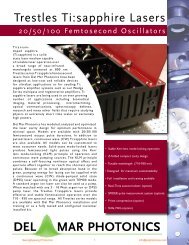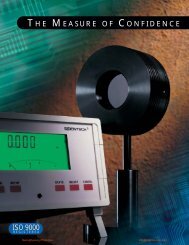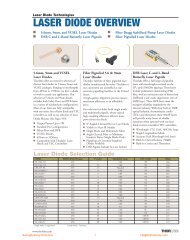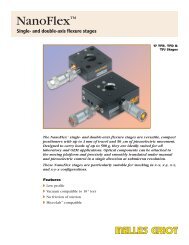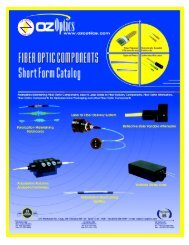SAM – saturable absorber mirror
SAM – saturable absorber mirror
SAM – saturable absorber mirror
- No tags were found...
You also want an ePaper? Increase the reach of your titles
YUMPU automatically turns print PDFs into web optimized ePapers that Google loves.
<strong>SAM</strong> ® <strong>–</strong> <strong>saturable</strong> <strong>absorber</strong> <strong>mirror</strong>product overview• for passive mode-locking of solid state,fiber or microchip lasersNewMiscellaneous relaxation times!New: <strong>SAM</strong> 1150nm!BATOP GmbHWildenbruchstrasse 1507745 JenaGermanyPhone:Fax:URL:e-mail:+49 3641 634009 - 0+49 3641 634009 - 20http://www.batop.deinfo@batop.de<strong>SAM</strong> 760laser wavelengthhigh reflection band (R>99%)<strong>saturable</strong> absorptionrelaxation timeλ = 760 nmλ = 740 - 780 nmA 0 = 1 - 5 %τ = 3 ps<strong>SAM</strong> 800laser wavelengthhigh reflection band (R>99%)<strong>saturable</strong> absorptionrelaxation timeλ = 800 nmλ = 780 - 810 nmA 0 = 1 - 8 %τ = 10 psmounting types<strong>SAM</strong> 940laser wavelengthhigh reflection band (R>99%)<strong>saturable</strong> absorptionrelaxation timeλ = 940 nmλ = 910 - 990 nmA 0 = 2 - 30 %τ = 500 fs<strong>SAM</strong> 980laser wavelengthhigh reflection band (R>99%)<strong>saturable</strong> absorptionrelaxation timeλ = 980 nmλ = 910 <strong>–</strong> 990 nmA 0 = 2 - 20 %τ = 500 fs<strong>SAM</strong> 1040laser wavelengthhigh reflection band (R>99%)<strong>saturable</strong> absorptionrelaxation timeλ = 1040 nmλ = 980 .. 1060 nmA 0 = 0.7 - 65 %τ = 500 fs / 10 ps12.7 mm ∅ - (1/2" ∅) - Cu-Mount<strong>SAM</strong> 1064laser wavelengthhigh reflection band (R>99%)<strong>saturable</strong> absorptionrelaxation timeλ = 1064 nmλ = 1030 .. 1100 nmA 0 = 0.5 - 70 %τ = 500 fs / 10 ps<strong>SAM</strong> 1150laser wavelengthhigh reflection band (R>99%)<strong>saturable</strong> absorptionrelaxation timeλ = 1150 nmλ = 1110 .. 1190 nmA 0 = 3 - 6 %τ = 500 fs25.4 mm ∅ - (1" ∅) - Cu-Mount<strong>SAM</strong> 1300laser wavelengthhigh reflection band (R>99%)<strong>saturable</strong> absorptionrelaxation timeλ = 1300 nmλ = 1220 .. 1340 nmA 0 = 4 - 12 %τ = 10 ps<strong>SAM</strong> 1550laser wavelengthhigh reflection band (R>99%)<strong>saturable</strong> absorptionrelaxation timeλ = 1550 nmλ = 1460 .. 1590 nmA 0 = 1 - 50 %τ = 2 ps / 10 psOther wavelengths and parameters on request.fiber coupled <strong>SAM</strong>SeongKyeong Photonics 1 info@skphotonics.com
Chip area:Chip thickness:Front side protection:Back side:Mount:5 mm x 5 mm400 µm semi <strong>–</strong> insulating GaAs,other thickness on requestAR coatingpolished and AR coated• unmounted• 12.7 mm ∅• 25.0 mm ∅• fiber coupled (SMF, PM)Cu-Mount ∅ 12.7 mm with ∅ 4 mm hole:Cu-Mount ∅ 25.0 mm with ∅ 4 mm hole:Spectral transmission / absorption:SA 1020-40-XSA 1064-40-XSA 2000-1-XSeongKyeong Photonics 6 info@skphotonics.com
A <strong>SAM</strong> consists of a Bragg-<strong>mirror</strong> on a semiconductor wafer like GaAs, covered by an<strong>absorber</strong> layer and a more or less sophisticated top film system, determining the <strong>saturable</strong>loss.Although semiconductor <strong>saturable</strong> <strong>absorber</strong> <strong>mirror</strong>s have been employed for mode-lockingin a wide variety of laser cavities, the <strong>SAM</strong> has to be designed for each specific application.The differing loss, gain spectrum, internal cavity power, etc, of each laser necessitatesslightly different <strong>absorber</strong> characteristics.The most important parameters of a <strong>SAM</strong> are:●●●●●<strong>saturable</strong> absorptionnon-<strong>saturable</strong> lossrelaxation timesaturation fluencereflection and absorption bandwidth.> 3. Saturable absorptionA <strong>SAM</strong> is a nonlinear optical device. Therefore the absorption A depends on the lightintensity I in the laser cavity byeq.(1)withΑ absorptionA 0 small signal absorption (<strong>saturable</strong> absorption)I light intensity (measured in W/m 2 )I sat saturation intensityThe absorption A is proportional to the square of the electric field strength of the standingwave at the position of the <strong>absorber</strong> layer. Therefore the <strong>saturable</strong> absorption of the <strong>SAM</strong>can be adjusted by the design.Typical values of the small signal (<strong>saturable</strong>) absorption A 0 and the saturation intensity I satare● A 0 = 1%● I sat = 10 MW/cm 2> 4. Non-<strong>saturable</strong> lossSeongKyeong Photonics 8 info@skphotonics.com
Non-<strong>saturable</strong> losses are caused by the transmission and the absorption of the Bragg<strong>mirror</strong>. The absorption of the thin film stack can be very low (< 0.1 %). The transmissionloss of the Bragg <strong>mirror</strong> decreases with increasing number of the high and low index filmpairs. The transmission loss of an AlAs/GaAs multilayer stack of 25 film pairs at the designwavelength is < 0.1 %.Beside this the high reflection band width and the group delay dispersion of the <strong>mirror</strong> hasto be taken into account, especially in the case of ultra short pulses.The sum of the non-<strong>saturable</strong> losses can be described by a value A ns , which is typical < 0.3% at the design wavelength.> 5. Relaxation timeThe <strong>saturable</strong> <strong>absorber</strong> layer consists of a semiconductor material with a direct band gapslightly lower than the photon energy. During the absorption electron-hole pairs are createdin the film. The relaxation time τ of the carriers has to be a little bit longer than the pulseduration. In this case the back side of the pulse is still free of absorption, but during thehole period between two consecutive pulses the <strong>absorber</strong> is non saturated and prevents Q-switched mode-locking of the laser.Because the relaxation time due to the spontaneous photon emission in a directsemiconductor is about 1 ns, some precautions has to be done to shorten it drastically.Two technologies are used to introduce lattice defects in the <strong>absorber</strong> layer for fast nonradiativerelaxation of the carriers:●●low-temperature molecular beam epitaxy (LT-MBE)ion implantation.The parameters to adjust the relaxation time in both technologies are the growthtemperature in case of LT-MBE and the ion dose in case of implantation.Typical values of the relaxation time τ of <strong>SAM</strong>s are between 0.3 and 2 ps.> 6. Saturation fluenceThe saturation process can be better quantified by the pulse fluence Φ than by the intensityI because of the limited relaxation time τ. To minimise the losses, the <strong>absorber</strong> should be<strong>saturable</strong> with the expected pulse fluence Φ, e.g. the pulse energy in the laser should beseveral times more than the saturation energy, but not too high because then the lasertends to exhibit multiple pulsing. An other limitation is the damage threshold of the <strong>SAM</strong>.A typical saturation fluence Φ sat is about 70 µJ/cm 2 .In the laser cavity the incident pulse fluence Φ can be adjusted by varying the illuminatedarea a on the <strong>SAM</strong>. If the intracavity pulse power is low, e.g. because of low pump power,then tighter focussing helps to achieve the necessary saturation fluence Φ sat of typicallysome ten µJ/cm 2 .In analogy to eq. (1) the (<strong>saturable</strong>) absorption A of the <strong>SAM</strong> can be calculated bySeongKyeong Photonics 9 info@skphotonics.com
eq.(2)withAA 0absorptionsmall signal absorptionΦ pulse fluence (J/m 2 )Φ satsaturation fluenceThe figure right shows the <strong>saturable</strong>absorption A in dependency of the fluencein case ofA 0 = 1 % and Φ sat = 0.1 mJ/cm 2 .The pulse fluence Φ can be derived from the mean output power P of the laser as follows:eq.(3)withΦ pulse fluence (measured in J/cm 2 )P mean output power of the laserR reflectance of the output <strong>mirror</strong>f repetition rate of the lasera illuminated area on the <strong>SAM</strong>> 7. Reflection and absorption bandwidth7.1 Time-bandwidth product (TBWP)From Heisenberg's uncertainty principle for the conjugated variables pulse width ∆t andphoton energy E = h . νthe TBWP of a laser pulse is limited to about ∆ t . ∆ν >1/(2π).●●●h = 6.626 . 10 -34 Js is Planck's constantν the pulse mean frequency and∆ν the pulse bandwidthAn accurate calculation shows, that the minimum TBWP for a Gaussian pulse is ∆t . ∆ν =0.44 (pulse duration in seconds x pulse bandwidth in Hertz > 0.44).The minimum TBWP for a Sech 2 pulse is ∆t . ∆ν = 0.32 .Most people do not work with frequency ν but prefer wavelength λ. Using the relation c=λ .ν the frequency interval ∆ν is related to the wavelength interval ∆λ by ∆ν = - c . ∆λ/λ 2 .c = 2.988 . 10 8 m/s is the speed of light in the vacuum.Numerical values for the minimum bandwidth ∆ν as a function of pulse duration ∆tSeongKyeong Photonics 10 info@skphotonics.com
Pulseduration∆tGaussianbandwidth∆νSech 2bandwidth∆νGaussian bandwidth ∆νSech 2 bandwidth ∆ν5 fs 88 THz 64 THz10 fs 44 THz 32 THz20 fs 22.THz 16 THz50 fs 8.8 THz 6.4 THz100 fs 4.4 THz 3.2 THz200 fs 2.2 THz 1.6 THz500 fs 880 GHz 640 GHz1 ps 440 GHz 320 GHz2 ps 220 GHz 160 GHz5 ps 88 GHz 64 GHz10 ps 44 GHz 32 GHz20 ps 22 GHz 16 GHzNumerical values for the minimum bandwidth in nm as a function of pulse duration ∆tGaussian bandwidth (nm)Sech 2 bandwidth (nm)PulsedurationDt@ 800nm@ 1200nm@ 1600nm@ 2000nm@ 800nm@ 1200nm@ 1600nm@ 2000nm5 fs 188 nm 424 nm 752 nm 1180 nm 137 nm 308 nm 547 nm 858 nm10 fs 94 nm 212 nm 377 nm 590 nm 68 nm 154 nm 274 nm 429 nm20 fs 47 nm 106 nm 188 nm 295 nm 34 nm 77 nm 137 nm 214 nm50 fs 19 nm 42 nm 75 nm 118 nm 13 nm 31 nm 55 nm 86 nm100 fs 9.4 nm 21 nm 38 nm 59 nm 6.8 nm 15 nm 27 nm 43 nm200 fs 4.7 nm 10.6 nm 18.8 nm 29.5 nm 3.4 nm 7.7 nm 13.7 nm 21.4 nm500 fs 1.9 nm 4.2 nm 7.5 nm 11.8 nm 1.4 nm 3.1 nm 5.5 nm 8.6 nm1 ps 0.94 nm 2.12 nm 3.77 nm 5.90 nm 0.69 nm 1.54 nm 2.74 nm 4.29 nm2 ps 0.47 nm 1.06 nm 1.88 nm 2.95 nm 0.34 nm 0.77 nm 1.37 nm 2.14 nm7.2 Reflection bandwidthSeongKyeong Photonics 11 info@skphotonics.com
The reflection bandwidth of the <strong>SAM</strong> has to be larger than the pulse bandwidth. In case ofa <strong>SAM</strong> with an underlying Bragg-<strong>mirror</strong> the reflection bandwidth is determined by the ratioof the refractive indices n H /n L of the layers in the thin film stack. More about Bragg<strong>mirror</strong>s...The relative spectral width w = ∆λ/λ of the high reflectance zone of a conventionalsemiconductor AlAs/GaAs thin film stack is about 0.1. Therefore the width of the highreflection zone of an AlAs/GaAs Bragg-<strong>mirror</strong> with a center wavelength of 1000 nm is about100 nm. From the tables above this results in a minimum pulse duration of about 20 fs. Forshorter pulses other <strong>mirror</strong> types, for instance dielectric or metallic <strong>mirror</strong>s has to be used.7.3 Absorption bandwidthAn ideal <strong>SAM</strong> has a constant <strong>saturable</strong> absorption for all wavelength of the pulse spectrum.In case of a 5 fs pulse the width of this wavelength interval is some hundreds ofnanometers.SeongKyeong Photonics 12 info@skphotonics.com
Refractive index > GaAs | AlAs | Al x Ga 1-x As | In x Ga 1-x As> Devices > Bragg <strong>mirror</strong> | <strong>SAM</strong> | R<strong>SAM</strong> | SANOS | SOC | PCASOC - Saturable Output Coupler> Contents● Aim of SOC● SOC parameters● Transmittance● Saturable absorption● Relaxation time● Reflectance bandwidth● Absorbance> Aim of SOCUsing a <strong>saturable</strong> output coupler (SOC), a selfstarting,passively mode-locked diode pumpedsolid-state laser with a very simple layout canbe arranged. A SOC is a combination of thewell known <strong>saturable</strong> <strong>absorber</strong> <strong>mirror</strong> (<strong>SAM</strong>)with an output coupler.In case of using a SOC instead of a <strong>SAM</strong> forpassive mode-locking the optical pump powercan be provided through the end <strong>mirror</strong> of thelaser cavity.Mode locking produces stable and coherentpulsed lasers by forcing the faces of themodes to maintain constant values relative toone another. These modes then combinecoherently. Fundamental mode-locking resultsin a train of optical pulses with a period of 2L/c, where L is the cavity length and c thespeed of the light in free space.Mode locking occurs when laser losses are modulated at a frequency equal to the reverse of the pulse periodc/2L. The SOC is a passive mode locking device without the use of an external drive signal, which spontaneouslylocks the modes with fast material response time.> SOC parametersA SOC consists of a Bragg-<strong>mirror</strong> on a semiconductor wafer like GaAs, covered by an <strong>absorber</strong> layer and a moreor less sophisticated top film system, determining the <strong>saturable</strong> loss. The back side of the SOC wafer isantireflection coated.The most important parameters of a SOC are:●●●●●transmittance<strong>saturable</strong> absorptionrelaxation timesaturation fluencereflectance bandwidth.> TransmittanceSeongKyeong Photonics 13 info@skphotonics.com
The transmittance of the <strong>saturable</strong> output coupler is mainly governed by the reflectance of the partial reflectorand the absorbance of the <strong>absorber</strong> layer. The number of film pairs in the quarter-wave stack of the AlAs/GaAspartial reflector (Bragg-<strong>mirror</strong>) determines the reflectance. It follows from the energy conservation law T + R +A = 1 (T - transmittance, R -reflectance, A - absorbance), that the transmittance is given by T = 1 - R - A.The reflectance of the Bragg <strong>mirror</strong> increases with increasing number of the high and low index film pairs. AnAlAs/GaAs multilayer stack of 10 film pairs has at the design wavelength a reflectance of ~ 96 % andconsequently a transmitttance of ~ 4%.> Saturable absorptionThe absorbance A of the SOC consists of two parts:●●<strong>saturable</strong> absorptionnon-<strong>saturable</strong> absorption.Both parts are proportional to the square of the electric field strength of the standing wave at the position of the<strong>absorber</strong> layer in front of the Bragg-<strong>mirror</strong>. Therefore the absorbance of the SOC can be adjusted by changingthe field distribution due to the design of the thin film stack.The dependency of the <strong>saturable</strong>absorption on the optical pulse fluence candescribed bywithΑ absorptionA 0 small signal absorption (<strong>saturable</strong> absorption)Φ pulse fluence (J/cm 2 )Φ sat saturation fluenceA typical value of the saturation fluence is70 µJ/cm 2 .The figure above shows the <strong>saturable</strong> absorption A in dependencyof the fluence in case of A 0 = 1 % and Φ sat = 0.1 mJ/cm 2 .The non-<strong>saturable</strong> absorption is the biggest part of the non-<strong>saturable</strong> losses. Due to the two-photon absorption itdepends on the power density. A typical ratio of the <strong>saturable</strong> and non-<strong>saturable</strong> absorption is around 1.The modulation depth ∆T of the SOC transmittance is ~ A 0 (<strong>saturable</strong> absorption).The pulse fluence Φ can be derived from the mean output power P of the laser as follows:Φ = P / (T . f . a)withPTfamean output power of the lasertransmittance of the output couplerrepetition rate of the laserilluminated area on the SOC.> Relaxation timeSeongKyeong Photonics 14 info@skphotonics.com
The <strong>saturable</strong> <strong>absorber</strong> layer consists of a semiconductor material with a direct band gap slightly lower than thephoton energy. During the absorption electron-hole pairs are created in the film. The relaxation time τ of thecarriers has to be a little bit longer than the pulse duration. In this case the back side of the pulse is still free ofabsorption, but during the whole period between two consecutive pulses the <strong>absorber</strong> is non saturated andprevents Q-switching.Because the typical relaxation time due to the spontaneous photon emission in a direct semiconductor is about 1ns, some precautions has to be done to shorten it drastically.Two technologies are used to introduce lattice defects in the <strong>absorber</strong> layer for fast non-radiative relaxation ofthe carriers:●●low-temperature molecular beam epitaxy (LT-MBE)ion implantation.The parameters to adjust the relaxation time in both technologies are the growth temperature in case of LT-MBEand the ion dose and annealing parameters in case of ion implantation.Typical values of the relaxation time of SOCs are between τ = 1 .. 10 ps.> Reflectance bandwidthThe reflectance bandwidth of the SOC has to be larger than the pulse bandwidth. The reflectance bandwidth isdetermined by the ratio of the refractive indices n H /n L of the layers in the Bragg <strong>mirror</strong> thin film stack. Moreabout Bragg-<strong>mirror</strong>s ...The relative spectral width w = ∆λ/λ of the high reflectance zone of a common semiconductor AlAs/GaAs thinfilm stack is about 0.1. Therefore the width of the high reflectance zone of an AlAs/GaAs Bragg-<strong>mirror</strong> with acentre wavelength of 1000 nm is about 100 nm. This results in a minimum pulse duration of about 20 fs.> AbsorbanceAn ideal SOC has a constant<strong>saturable</strong> absorption for allwavelengths of the pulsespectrum. The absorption ofa direct semiconductorincreases heavily withincreasing photon energy,starting at the gap energyof the semiconductormaterial. In case of aquantum well structure theabsorption increases as astep-like dependency on thephoton energy due to theone-dimensionalquantisation of free carriers.In any case the result is anincreasing <strong>saturable</strong>absorption of a SOC withdecreasing wavelength(increasing photon energy).Consequently, thereflectance versuswavelength curve of a SOCreveals under non-saturatedconditions a decreasingreflectance with decreasingwavelength.SeongKyeong Photonics 15 info@skphotonics.com
Refractive index > GaAs | AlAs | Al x Ga 1-x As | In x Ga 1-x As> Devices > Bragg <strong>mirror</strong> | <strong>SAM</strong> | R<strong>SAM</strong> | SANOS | SOC | PCAR<strong>SAM</strong> - Resonant Saturable Absorber Mirror> Contents● How does a R<strong>SAM</strong> work?● R<strong>SAM</strong> applications● Resonance wavelength● Bandwidth● Saturation intensity● Intensity dependent reflectance● Relaxation time> How does a R<strong>SAM</strong> work?The resonant <strong>saturable</strong> <strong>absorber</strong> <strong>mirror</strong> (R<strong>SAM</strong>) is a similardevice as a <strong>saturable</strong> <strong>absorber</strong> <strong>mirror</strong> (<strong>SAM</strong>), but has a larger<strong>saturable</strong> absorption, a smaller bandwidth and a lowersaturation fluence. The R<strong>SAM</strong> is designed as a resonantGires<strong>–</strong>Tournois interferometer with <strong>absorber</strong> layerspositioned at the antinodes of the optical field inside theresonator cavity.The R<strong>SAM</strong> is a nonlinear optical device, having a lowreflectance for week optical signals like noise and a highreflectance for high power signals like optical pulses. Opticalpulses saturate the <strong>absorber</strong> material inside the resonantcavity of the R<strong>SAM</strong>. Due to the short recovery time of the<strong>absorber</strong> material the R<strong>SAM</strong> blocks immediately after thereflected pulse the optical noise floor.Important parameters of the R<strong>SAM</strong> are the●●●Resonance wavelengthBandwidthSaturation power density or the saturation fluence.> R<strong>SAM</strong> applicationsThe main applications for R<strong>SAM</strong>s are:● optical noise suppression, for example after an EDFA or a pulse picker (unsaturated R<strong>SAM</strong> reflectance = 0) -->SANOS (SAturable NOise Suppressor)● opto-optical wavelength conversion (unsaturated R<strong>SAM</strong> reflectance = 0)● passive mode-locking of fiber lasers (unsaturated R<strong>SAM</strong> reflectance > 0).> Resonance wavelengthInfluence of the angle of incidenceThe resonance wavelength λ of the Gires<strong>–</strong>Tournois interferometer depends on the angle of incidence ϕ and is given byeq.(1)withSeongKyeong Photonics 16 info@skphotonics.com
λ resonance wavelength of the interferometernrefractive index of the absorbing spacer layerd thickness of the absorbing spacer layerm order of the resonance; m = 1, 2, 3, ....ϕ angle of incidence on the R<strong>SAM</strong>In case of a perpendicular beam incidence the first order resonance wavelength is simply λ = 2nd.Resonance wavelength λ of a R<strong>SAM</strong>with λ(0) = 1064 nm and n = 3.1 after eq. (1)Resonance wavelength for parallel polarizedlight at different angles of incidenceSeongKyeong Photonics 17 info@skphotonics.com
Resonance wavelength for perpendicularpolarized light at different angles of incidenceInfluence of the temperatureThere is also a temperature influence on the resonance wavelength λ. The temperature dependency of the opticalthickness nd of the absorbing spacer layer, which governs the resonance wavelength λ, is mainly determined by therefractive index. The influence of the thermal expansion of the layer thickness is negligible.The change of the resonance wavelength λ with the temperature can be calculated byeq.(2)withλ (T) resonance wavelength at temperature Tλ (T 0 ) resonance wavelength at reference temperature T 01/n*dn/dT ~ 7.5x10 -5 K -1 , temperature coefficient of the refractive indexT 0 reference temperatureT working temperatureResonance wavelength λ of a R<strong>SAM</strong> with λ(0) = 1064 nmafter eq. (2)> BandwidthThe bandwidth ∆λ of the interferometer resonance dip is gouverned by the round trip loss l of the wave inside thecavity and can be estimated in case of small losses l
with∆λ bandwidth FWHM (full width at half maximum)λ resonance wavelength of the interferometer(r f ) 2 = R f reflectance of the front <strong>mirror</strong> (back <strong>mirror</strong> reflectance R b = 1)A single pass absorptance of the spacer layerm order of the resonance; m = 1, 2, 3, ....lround trip loss: 1 - r f + A∆λ for R<strong>SAM</strong>at λ = 1064 nmR<strong>SAM</strong>, impedance matched at λ = 1064 nm with front <strong>mirror</strong> reflection r f = 0.97,unsaturated absorption of A = 1.5% and resonance order m = 4> Saturation intensitySeongKyeong Photonics 19 info@skphotonics.com
The R<strong>SAM</strong> is a strong nonlinear optical device. The absorptance A of the <strong>absorber</strong> layer and the reflectance R of theR<strong>SAM</strong> depend on the incoming light intensity I. Due to the resonance condition of the Gires<strong>–</strong>Tournois interferometer atthe working wavelength the effective saturation intensity I sat,eff of the device shifts by a factor of about (π/F) 2 (F -finesse of the Gires<strong>–</strong>Tournois interferometer) to lower values in relation to the intrinsic material value I sat , which isvalid for non-resonant <strong>saturable</strong> <strong>absorber</strong> <strong>mirror</strong>s (<strong>SAM</strong>).The absorptance A of a R<strong>SAM</strong> with a not too small finesse F > 10 can be estimated byeq.(3)withΑ absorptanceA 0 small signal absorptance (<strong>saturable</strong> absorption)I light intensity (measured in W/m 2 )I sat intrinsic material saturation intensityF finesse of the R<strong>SAM</strong>The effective saturation fluence Φ sat,eff of a R<strong>SAM</strong> can be estimated using the relaxation time τ and the effectivesaturation intensity I sat,effeq.(4)withΦ sat,effI sat,effτeffective saturation fluence of the R<strong>SAM</strong>effective saturation intensity of the R<strong>SAM</strong>relaxation time of the <strong>absorber</strong> materialWith typical values for a non-resonant <strong>SAM</strong>● I sat = 10 MW/cm 2●τ = 10 ps● Φ sat = 100 µJ/cm 2the relevant parameters for a R<strong>SAM</strong> with a finesse F = 20 can be estimated to● I sat,eff = 250 kW/cm 2● Φ sat,eff = 2.5 µJ/cm 2In this way the effective saturation values can be decreased to very low values at the expense of a small usuablespectral bandwidth.> Intensity dependent reflectanceSeongKyeong Photonics 20 info@skphotonics.com
R<strong>SAM</strong> at λ = 1064 nm with front <strong>mirror</strong> reflection r f = 0.97,unsaturated absorption of A = 1.5% and resonance order m = 4> Relaxation timeThe <strong>saturable</strong> <strong>absorber</strong> layer consists of asemiconductor material with a direct bandgap, which is slightly smaller than thephoton energy. During the absorptionelectron-hole pairs are created in the film.The relaxation time τ of the carriers is veryshort due to fast non-radiative relaxationchannels introduced by low-temperaturegrowth of the <strong>absorber</strong> layer.Recovery of the absorption A 0with a relaxation time τ = 10 psTypical values of the relaxation time τ arebetween 5 and 20 ps.The relaxation of the carriers and therecovery of the absorption A(t) after thesaturation can be described asA(t) = A 0 [1 - exp(-t/τ )]withA(t)A 0tτtime dependent absorptionsmall signal <strong>saturable</strong> absorptiontimerelaxation timeSeongKyeong Photonics 21 info@skphotonics.com
Refractive index > GaAs | AlAs | Al x Ga 1-x As | In x Ga 1-x As> Devices > Bragg <strong>mirror</strong> | <strong>SAM</strong> | R<strong>SAM</strong> | SANOS | SOC | PCASANOS - Saturable Noise Suppressor> Contents● How works a SANOS?● SANOS applications● Free space SANOS● Fibre coupled SANOS● Effective saturation fluence Φ sat,eff●●●Relaxation time constant τEffective saturation intensity I sat,effBandwidth> How works a SANOS?The active element of a SANOS is a resonant<strong>saturable</strong> <strong>absorber</strong> <strong>mirror</strong> (R<strong>SAM</strong>) with zeroreflectance for a low power signal at theresonance wavelength. The R<strong>SAM</strong> is anonlinear optical device, having a lowreflectance for week optical signals like noiseand a high reflectance for high power signalslike optical pulses.A typical non-linear transfer function of aSANOS is shown in the figure left. Thetransmittance of the SANOS is shown as afunction of the peak puls intensity I. Thetypical effective saturation intensity I sat,eff is~2 MW/cm 2 .A SANOS is mainly characterized by the following parameters:●●●●●the effective saturation fluence Φ sat,effthe relaxation time constant τthe effective saturation intensity I sat,effthe usuable spectral bandwidth ∆λthe insertion loss L> SANOS applicationsSeongKyeong Photonics 22 info@skphotonics.com
The main applications for SANOS are:●●●noise suppression in free space optics, for example after a pulse pickerreshaping of fibre guided optical signalsopto-optical wavelength conversion.For these two applications the following devices has been developed:●●Free space SANOS (FS-SANOS)Fibre coupled SANOS (FC-SANOS)> Free space SANOS (FS-SANOS)The free space SANOS is devoted to clean a pulsed opticalbeam from noise. One possible application is after a pulsepicker to suppress the residual pulses, which has been passedthe picker with a low intensity. An other application is tosuppress the amplified spontaneous emission (ASE) of anoptical amplifier.The optical beam is twofold reflected inside the FS-SANOS.The first <strong>mirror</strong> is a nonlinear R<strong>SAM</strong>. The second <strong>mirror</strong> iseither a common linear high reflectance <strong>mirror</strong> or a R<strong>SAM</strong>.The transmittance T of the FS-SANOS depends on the peak power density I of the input beam accordingto the nonlinear reflectance of the R<strong>SAM</strong>. The output beam intensity I out is related to the input beamintensity I bywithT(I)I out = T(I) Iintensity dependent transmittance.A typical transmittance curve of a FS-SANOS with one R<strong>SAM</strong> inside shows the figure above.> Fibre coupled SANOS (FC-SANOS)The fibre coupled SANOS can be used for noise suppression inoptical fibre channels. To reshape an optical signal the passiveFC-SANOS can be simply insert into a fibre channel after anEDFA. Due to the working principle of the SANOS this devicereshapes only the amplitude of one wavelength.The active device inside the FC-SANOS is a R<strong>SAM</strong>, mounted ona circulator.> Effective saturation fluence Φ sat,effSeongKyeong Photonics 23 info@skphotonics.com
The effective saturation fluence Φ sat,eff of a SANOS can be defined in such a way, that the transmittance Tat Φ sat,eff is 50% of the saturated value at a very large fluence Φ >> Φ sat .Corresponding to the finesse of the R<strong>SAM</strong> Φ sat,eff of a SANOS is smaller than the saturation fluence Φ sat ofthe <strong>absorber</strong> material inside the R<strong>SAM</strong>. The finesse also limits the bandwidth FWHM of the resonance dipat the operation wavelength. The figure below shows the relation between the effective saturation fluenceΦ sat,eff as a function of the bandwidth full width of half maximum (FWHM). For decreasing the FWHM theeffective saturation fluence Φ sat,eff is also decreasing if the cavity thickness remains constant. On the otherhand for a fixed FWHM the effective saturation fluence Φ sat,eff is increasing if the optical thickness of theR<strong>SAM</strong> cavity is increased.The effective saturationfluence Φ sat,eff as a functionof the full width at halfmaximum (FWHM) of theR<strong>SAM</strong> resonance dip plottedfor different R<strong>SAM</strong> cavitythicknesses.> Relaxation time constant τDecrease of the transmittance aftersaturation with τ = 10 psThe low temperature grown <strong>saturable</strong><strong>absorber</strong> layer inside the SANOS has arelaxation time constant τ, which can bevaried over a large region from about 100fs up to 100 ps. A typical value of therelaxation time τ is 1 ps.The relaxation of the carriers and thechange of the transmittance T(t) after thesaturation can be described asSeongKyeong Photonics 24 info@skphotonics.com
T(t) = T max exp(-t/τ )]withT(t)T maxtτtime dependent transmittacesaturated transmittancetimerelaxation time constant> Effective saturation intensity I sat,effThe effective saturation intensity I sat,eff is related to the effective saturation fluence Φ sat,eff byΦ sat,eff = I sat,eff τ.With Φ sat,eff = 7 µJ/cm 2 and τ = 10 ps the effective saturation intensity is I sat,eff = 700 kW/cm 2 .> BandwidthThe spectral bandwidth of the SANOS is gouverned by the used R<strong>SAM</strong> bandwidth. A compromise isneeded between a large bandwidth and a low saturation fluence Φ sat , because the saturation fluencedecreases together with the bandwidth. A typical bandwidth (FWHM) of ~ 20 nm is possible for a SANOSwith Φ sat = 5 µJ/cm 2 . The usuable spectral bandwidth ∆λ around the low-intensity minimum transmittanceis by a factor of 5 ... 10 smaller than the FWHM and is therefore only some nanometers.SeongKyeong Photonics 25 info@skphotonics.com
Refractive index > GaAs | AlAs | Al x Ga 1-x As | In x Ga 1-x As> Devices > Bragg <strong>mirror</strong> | <strong>SAM</strong> | SA | R<strong>SAM</strong> | SOC | SANOS | PCASA - Saturable Absorber in transmission> Contents● Aim of SA● SA parameters● Transmittance● Saturable absorption● Relaxation time> Aim of SAThe <strong>saturable</strong> <strong>absorber</strong> in transmission can be used to realize a mode-locked fiber ringlaser.On other application is the use as mode-locking device in a diode pumped solid-statelaser for longer lasing wavelength > 1600 nm, where the preparation of a <strong>saturable</strong><strong>absorber</strong> <strong>mirror</strong> (<strong>SAM</strong>) with an AlAs/GaAs Bragg-<strong>mirror</strong> is too expensive.> SA parametersA SA consists of a group of absorbing InGaAs quantum wells on a semiconductor waferlike GaAs, covered on both sides with an antireflection coating.The most important parameters of a SA are:●●●●transmittance<strong>saturable</strong> absorptionrelaxation timesaturation fluence> TransmittanceThe transmittance of the <strong>saturable</strong> <strong>absorber</strong> is mainly governed by the absorbance ofthe quantum well stack. Ideally the reflectance of the device is zero because of theantireflection coating on both sides of the semiconductor chip. It follows from theenergy conservation law T + R + A = 1 (T - transmittance, R -reflectance, A -absorbance), that the transmittance is T ~ 1 - A.> Saturable absorptionSeongKyeong Photonics 26 info@skphotonics.com
The absorbance A of the SA consists of two parts:●●<strong>saturable</strong> absorptionnon-<strong>saturable</strong> absorption.The ratio between the <strong>saturable</strong> and the non-<strong>saturable</strong> part of the absorption dependsmainly on the relaxation time of the excited carriers in the absorbing quantum wells.For a fast <strong>absorber</strong> with a relaxation time ~ 300 fs, this ratio is about one. It means,that in this case 50% of the absorbance is <strong>saturable</strong> and the other 50% non-<strong>saturable</strong>.For <strong>absorber</strong>s with a relaxation time of about 10 ps the <strong>saturable</strong> part of the absorptionis about 70%. This part incrises further with increasing saturation time. The <strong>saturable</strong>part of the absorption is also known as modulation depth ∆ R.> Relaxation timeThe <strong>saturable</strong> <strong>absorber</strong> layer consists of a semiconductor material with a direct bandgap slightly lower than the photon energy. During the absorption electron-hole pairsare created in the film. The relaxation time τ of the carriers has to be a little bit longerthan the pulse duration. In this case the back side of the pulse is still free ofabsorption, but during the whole period between two consecutive pulses the <strong>absorber</strong>is non saturated and prevents Q-switching.Because the typical relaxation time due to the spontaneous photon emission in a directsemiconductor is about 1 ns, some precautions has to be done to shorten it drastically.Two technologies are used to introduce lattice defects in the <strong>absorber</strong> layer for fast nonradiativerelaxation of the carriers:●●low-temperature molecular beam epitaxy (LT-MBE)ion implantation.The parameters to adjust the relaxation time in both technologies are the growthtemperature in case of LT-MBE and the ion dose and annealing parameters in case ofion implantation.Typical values of the relaxation time of SAs are between τ = 1 .. 10 ps.SeongKyeong Photonics 27 info@skphotonics.com







